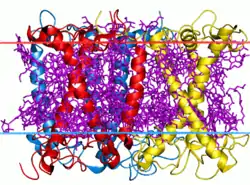Light-harvesting complexes of green plants
The light-harvesting complex (or antenna complex; LH or LHC) is an array of protein and chlorophyll molecules embedded in the thylakoid membrane of plants and cyanobacteria, which transfer light energy to one chlorophyll a molecule at the reaction center of a photosystem.
| Chlorophyll A-B binding protein | |||||||||
|---|---|---|---|---|---|---|---|---|---|
 Light-Harvesting Complex II (LHCB) | |||||||||
| Identifiers | |||||||||
| Symbol | Chloroa_b-bind | ||||||||
| Pfam | PF00504 | ||||||||
| InterPro | IPR022796 | ||||||||
| SCOP2 | 1rwt / SCOPe / SUPFAM | ||||||||
| OPM superfamily | 2 | ||||||||
| OPM protein | 1rwt | ||||||||
| |||||||||
The antenna pigments are predominantly chlorophyll b, xanthophylls, and carotenes. Chlorophyll a is known as the core pigment. Their absorption spectra are non-overlapping and broaden the range of light that can be absorbed in photosynthesis. The carotenoids have another role as an antioxidant to prevent photo-oxidative damage of chlorophyll molecules. Each antenna complex has between 250 and 400 pigment molecules and the energy they absorb is shuttled by resonance energy transfer to a specialized chlorophyll-protein complex known as the reaction center of each photosystem.[1] The reaction center initiates a complex series of chemical reactions that capture energy in the form of chemical bonds.
For photosystem II, when either of the two chlorophyll a molecules at the reaction center absorb energy, an electron is excited and transferred to an electron acceptor molecule, pheophytin, leaving the chlorophyll a in an oxidized state. The oxidised chlorophyll a replaces the electrons by photolysis that involves the oxidation of water molecules to oxygen, protons and electrons.
The N-terminus of the chlorophyll a-b binding protein extends into the stroma where it is involved with adhesion of granal membranes and photo-regulated by reversible phosphorylation of its threonine residues.[2] Both these processes are believed to mediate the distribution of excitation energy between photosystems I and II.
This family also includes the photosystem II protein PsbS, which plays a role in energy-dependent quenching that increases thermal dissipation of excess absorbed light energy in the photosystem.[3]
LH 1
Light-harvesting complex I is permanently bound to photosystem I via the plant-specific subunit PsaG. It is made up of four proteins: Lhca1, Lhca2, Lhca3, and Lhca4, all of which belong to the LHC or chlorophyll a/b-binding family. The LHC wraps around the PS1 reaction core.[4]
LH 2
The LH 2 is usually bound to photosystem I, but it can undock and bind PS I instead depending on light conditions.[4] This behavior is controlled by reversible phosphorylation. This reaction represents a system for balancing the excitation energy between the two photosystems.[5]
References
- Voet D, Voet JG (2011). Biochemistry 4th Ed. USA: Wiley. pp. 906. ISBN 978-0470-57095-1.
- Yang DH, Paulsen H, Andersson B (January 2000). "The N-terminal domain of the light-harvesting chlorophyll a/b-binding protein complex (LHCII) is essential for its acclimative proteolysis". FEBS Letters. 466 (2–3): 385–8. doi:10.1016/S0014-5793(00)01107-8. PMID 10682866. S2CID 19716587.
- Li XP, Gilmore AM, Caffarri S, Bassi R, Golan T, Kramer D, Niyogi KK (May 2004). "Regulation of photosynthetic light harvesting involves intrathylakoid lumen pH sensing by the PsbS protein". The Journal of Biological Chemistry. 279 (22): 22866–74. doi:10.1074/jbc.M402461200. PMID 15033974.
- Grotjohann I, Fromme P (2013). "Photosystem I". Encyclopedia of biological chemistry (Second ed.). London. pp. 503–507. doi:10.1016/B978-0-12-378630-2.00287-5. ISBN 978-0-12-378630-2.
- Liu XD, Shen YG (July 2004). "NaCl-induced phosphorylation of light harvesting chlorophyll a/b proteins in thylakoid membranes from the halotolerant green alga, Dunaliella salina". FEBS Letters. 569 (1–3): 337–40. doi:10.1016/j.febslet.2004.05.065. PMID 15225658. S2CID 23367090.